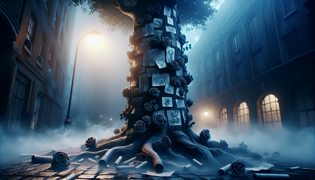Introduction
Night draped its velvet shawl across the cobbled streets of Areguá, where clay roof tiles and whitewashed walls seemed to glow under the pale promise of a full moon. In that silver radiance, the outlines of ancient jacaranda trees danced across timeworn facades, their blossoms dropping like soft tears upon the stones. A single lantern flickered at the threshold of a pottery workshop, yet even its golden warmth could not tame the hush that lay over the old town. Every shuttered window and closed door seemed to hold its breath, as though Areguá itself were waiting for something—or someone—to return. The scent of orange groves on the breeze drifted across Plaza Independencia, mingling with the distant lap of river water against the stone embankment. It was in that fragile stillness that the first whispers began: tales of a wandering spirit, pale as moonlight, treading the narrow lanes in search of a lost beloved. They said her heart was so heavy with longing that the echo of her footsteps filled each alleyway, calling through time for her one true love. Tourists dismissed it as fanciful rumor; old women warned children not to tarry after dusk; potters shut shop early and barred their doors once darkness crept over the lake. Yet every night, without fail, figures walking under the Colombian bugambilias swore they saw a delicate shape gliding past, trailing veils of mist. Some claimed her serenade was a song in Guaraní, rich with longing and sorrow, while others spoke of a rose pinned to her ghostly breast, forever blooming for a devotion that death could not sever. This is the tale of that restless spirit of Areguá—her yearning heart, her moonlit vigil, and the traveler drawn into the mystery of love that lingers even beyond the grave.
Echoes of the Past
In the hush before midnight, the spirit’s story began centuries ago, when Areguá was but a cluster of adobe homes and clay workshops nestled on the riverbank. Once known as Marangatu, the village’s heart pulsed with artisans shaping red clay into bowls, vases, and figurines—each piece a testament to tradition and skill. It was during this vibrant era that Rosalía, a young potter’s daughter, first met Esteban, a traveling musician whose guitar sang of distant lands. Their eyes met beside an old well at sunset, and by the next dawn the entire town murmured of the passion that bloomed between them. They stole secret moments behind bakeries and beneath the altar of the chapel, their laughter drifting through orange groves like silver bells. But fate’s design was not kind: a fever took Esteban when he fell ill on a journey north, and Rosalía prayed night and day beside his bedside in a makeshift inn. When news came that he had passed away under a linden tree, his guitar strings still humming in the wind, her spirit shattered. Stricken by grief, she wandered for nights by the water’s edge, searching in every glint of moonlight for a sign he still lived. When dawn arrived, she vanished into the mist—and the people found only her discarded shawl on the lakeshore.
By the time her family tore down walls to search each attic and courtyard, there was no trace of the living girl they loved so dearly. Only the memory of her soft voice, calling across the night, remained sewn into the shutters and inlaid doors of every home. Whispers said she climbed rooftops to peer over chimneys and slipped through iron lattices, unwilling to accept that death could claim her love. Mothers cautioned their children: “If Rosalía crosses your path, offering a red rose, do not follow her or you will also be lost to the world of the living.” Yet many returned breathless, speaking of a pale woman whose song could freeze the heart itself, her outstretched hand beckoning with petals of jasmine and fire.

On moonlit evenings, the echoes of that ancient heartache still cling to Areguá’s narrow lanes. Tourists stroll past mosaics and handpainted pottery stalls, oblivious to the phantom who glides just beyond the lamplight. Candlelit restaurants spill laughter onto the plazas, but when the lanterns are snuffed, that laughter fades into silence. In the soft sigh of the breeze and the restless ripple of the river, one might think they hear Rosalía’s sigh, longing for a love that time cannot release.
Under the Silver Moon
Few outsiders have ventured far into Areguá after dusk, but when Miguel journeyed from Asunción seeking inspiration for his paintings, he arrived at dusk—unaware of the warnings hushed by locals. He carried brushes and canvas rolls packed snugly at his back, his eyes alive with curiosity. When the moon rose, he noticed a pale figure drifting through the archway at Calle 6 de Enero. At first, he thought her the subject of a dream: she wore an ivory gown, and her feet brushed the stone without a sound. He raised his sketchbook and sketched furiously by lantern glow, fearing the moment would slip like water through his fingers if he blinked. Every line tried to capture the soft curve of her neck, the gentle slump of her shoulders, and the rose pinned to her bodice as if pressed against a living heart.
As he painted, Rosalía halted before a wrought-iron balcony decorated with ceramic planters spilling geraniums. Miguel heard a faint melody—her lament in Guaraní—sweet as honey yet steeped in longing. He set down his brush and followed, slipping past shuttered doors into an alley thick with moonlight and jasmine. Her song led him through twisting lanes until the town’s brightly painted facades gave way to overgrown gardens and mossy staircases. He sensed her sorrow in the hush of petals falling at his feet, soft and relentless. Yet every time he spoke her name, she vanished, leaving only the echo of her weeping in the star-filled sky.

Night after night, Miguel returned—staying in modest hospedajes where he left fresh plates of empanadas and cups of yerba mate on doorstep thresholds. He felt compelled to ease her longing, convinced that the spirit’s quest might be stilled if she understood that mortal gestures could echo across realms. Some evenings he whispered stories of his own lost love—an artist’s partner who journeyed abroad and never came back—and Rosalía’s head would tilt as though she recognized the echo of his own heartbreak. Sometimes she paused at the foot of a stairwell built of volcanic stone, turning her head toward the distant lights of the artisan workshops, before drifting on as though driven by an unseen force. Miguel’s sketches multiplied into paintings, each capturing different angles of her sorrow: the way her hair fanned in the breeze, the curve of her silhouette against peeling walls, the glow of lamplight shining through her translucent gown.
Then one night, as he adjusted the focus of his charcoal, he noticed a change: her shape shivered, as if uncertain whether to linger or move on. He dared to speak aloud—a single word of comfort in Guaraní—and watched her shoulders relax. For the first time, Miguel felt hope. Under that silver moon, the world seemed poised between grief and release, as though her story might yet find an ending written in forgiveness rather than pain.
The Spirit’s Lament and the Town’s Memory
By the seventh night of Miguel’s vigil, the people of Areguá took note of candles flickering in courtyards long since shuttered. Shopkeepers sensed a shift in the air—a hush broken only by what sounded like soft footsteps in the plaza. They began to leave water at doorsteps and bread by the wells, hoping to soothe a forlorn soul. Some offered prayers in the chapel of San Buenaventura; others spun stories by the flicker of oil lamps, weaving fragments of Rosalía’s life into legends bound in cloth and pottery. But the spirit moved on, gathering those gestures in a silent catalog of compassion that seemed to weigh against her unending sorrow.
Miguel, too, tried every kindness: he set out handcrafted tiles in the shape of red roses, played alchemic chords on his guitar tuned to midnight keys, and read aloud letters he imagined Rosalía might have written to Esteban. With every offering, he felt the air around him quiver as though the town itself was breathing in unison with her longing. Once, he glimpsed the outline of Esteban’s guitar leaning against a low wall; for a fleeting heartbeat, the two ghosts seemed reunited beneath the pale glow of night. He dared hope they might walk home together, leaving the living in peace. But when dawn’s first amber light crept across rooftops, he saw only two roses—one red, one yellow—tangled at the foot of the jalousied door.

In the end, Miguel understood that some grief cannot be undone, only honored. One final evening he traced Rosalía’s path from plaza to riverbank, his sketches pinned to trees and stones like memorials. She paused once more, her eyes reflecting the tangle of stars above, and raised the rose she always wore. Then, with a grace that belied centuries of sorrow, she placed that blossom on his canvas and vanished into the rising mist. The papers fluttered, carrying her farewell into the gentle current of the Paraná tributary. In that instant, he felt her yearning become a memory—something sacred to be carried forward rather than chased.
Today, in the glow of dawn, Areguá’s village square still carries the echo of her lament. Visitors marvel at murals depicting a lady of moonlight and at handpainted pottery that bears her likeness. Yet when night falls and the jasmine trees spill their fragrance once more, locals pause at every curve of cobblestone, half expecting to see a pale form drifting through the lamplight. And they smile, knowing some spirits never leave entirely.
Conclusion
Long after Miguel returned to Asunción with his paintings and stories, the spirit of Rosalía remained woven into every brushstroke and whispered in each tale shared beside the lake. Though she never found her mortal beloved again, her lament shaped the very soul of Areguá—reminding villagers and travelers alike that love’s echo can transcend life and death. Today, pottery shops and cafés celebrate her memory: a rose motif blossoms on every tile, and musicians strike midnight chords in the plaza in homage to her final farewell. And when the moon climbs high and the breeze carries petals from jacaranda trees, visitors swear they feel her presence, guiding the lost and comforting the grieving. Her wanderings have become a testament: that even in absence, the heart’s devotion paints its own eternity, warming the cold night with the soft glow of remembrance and hope that love—once true—never truly fades away, but lives on in every whispered legend under the silvered sky of Areguá.


















